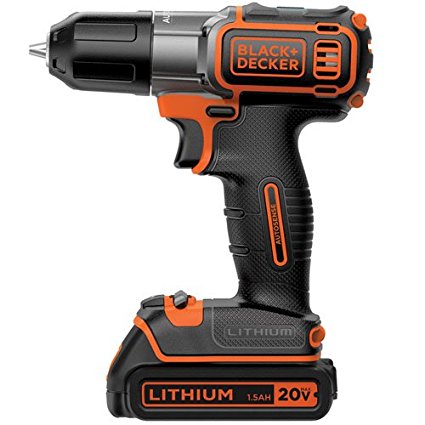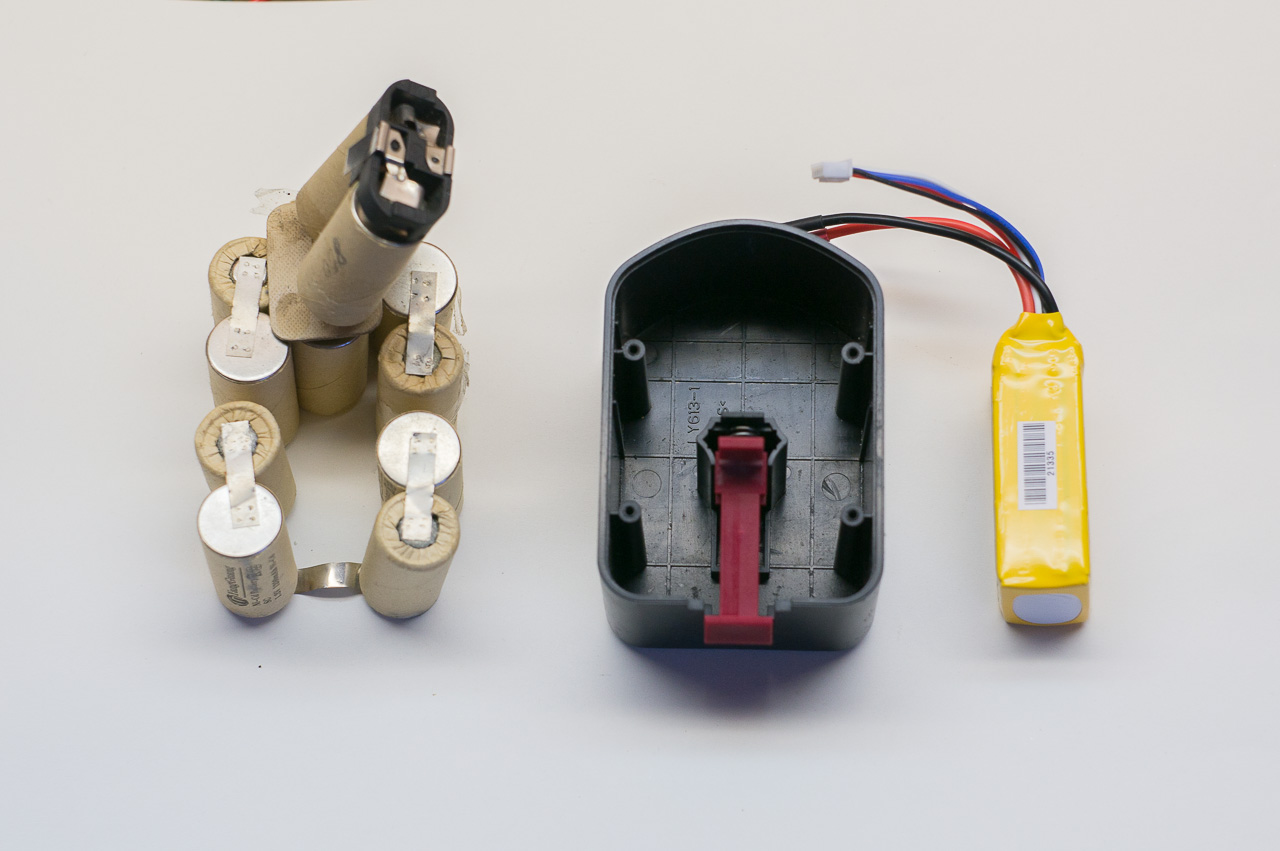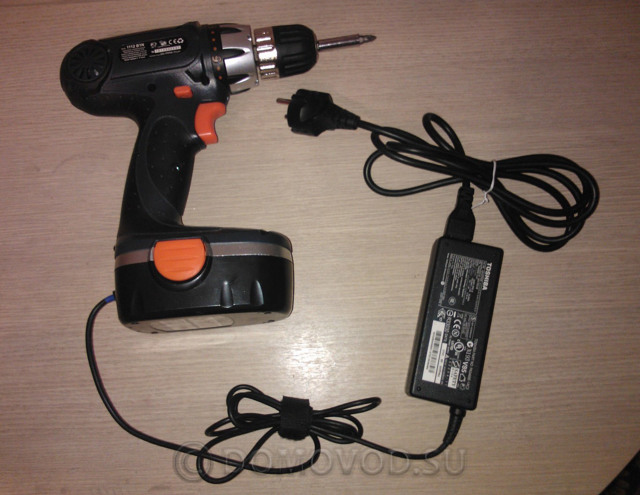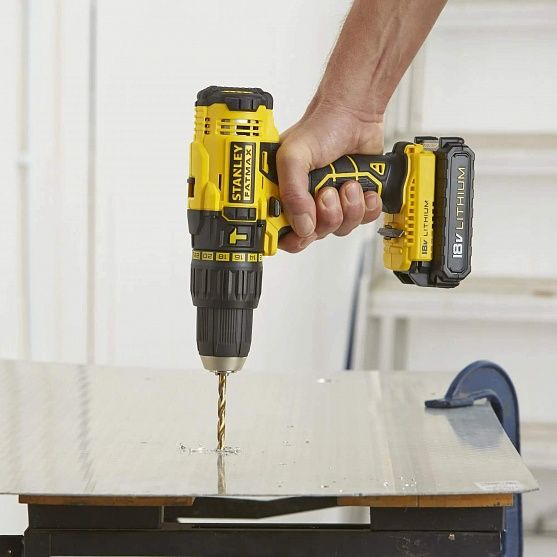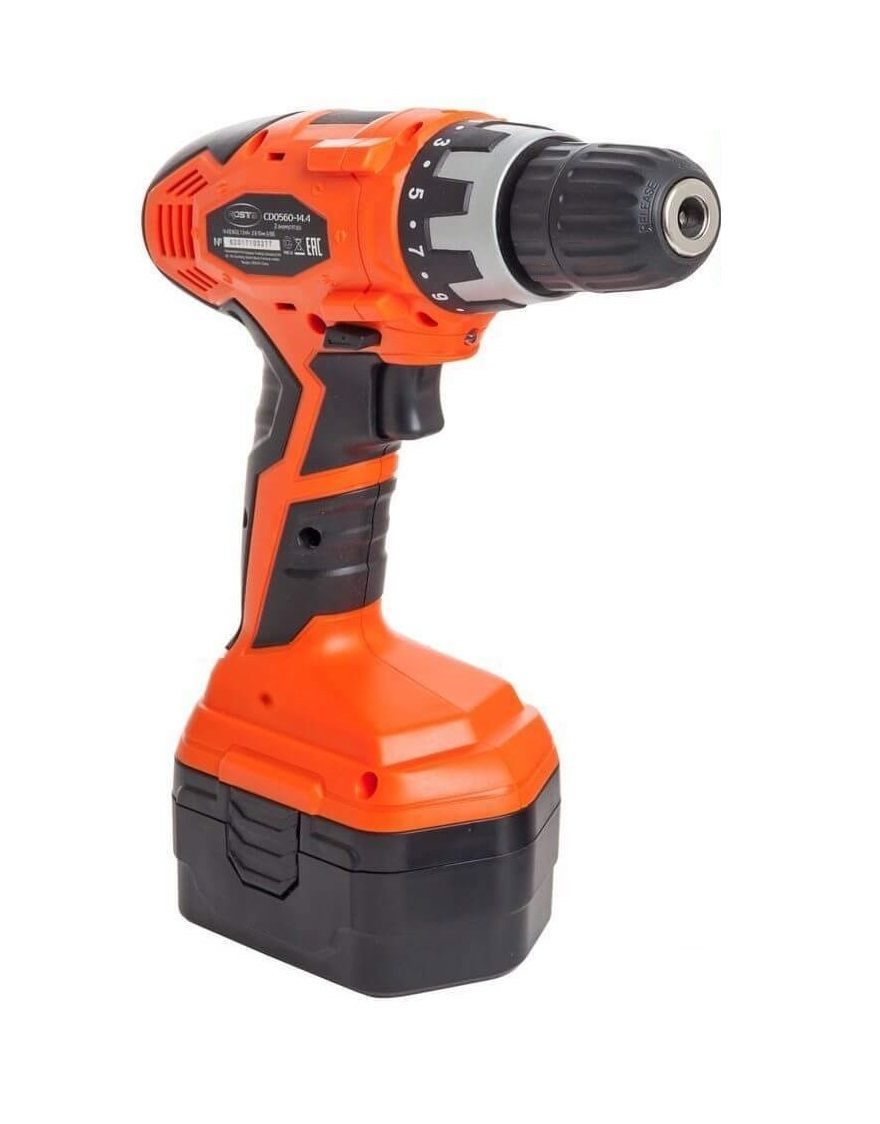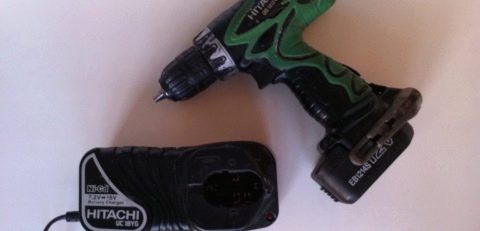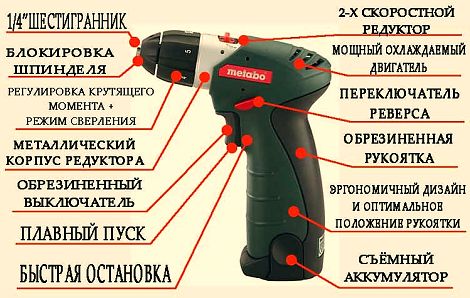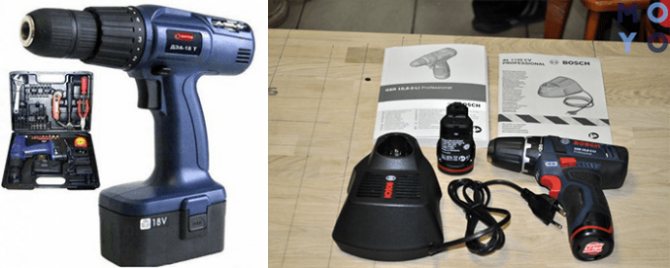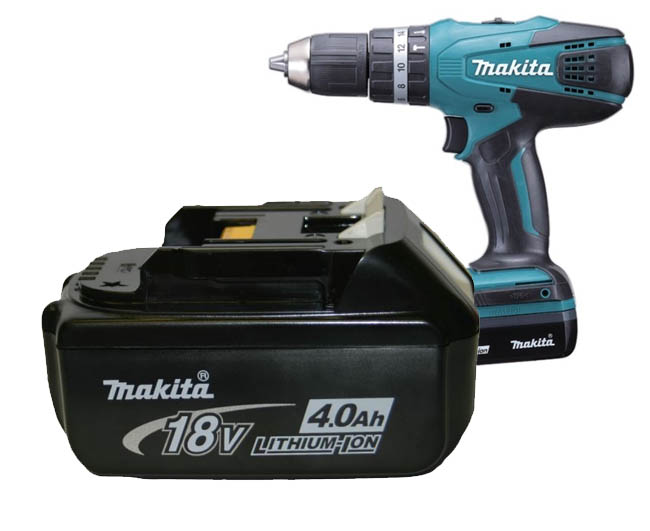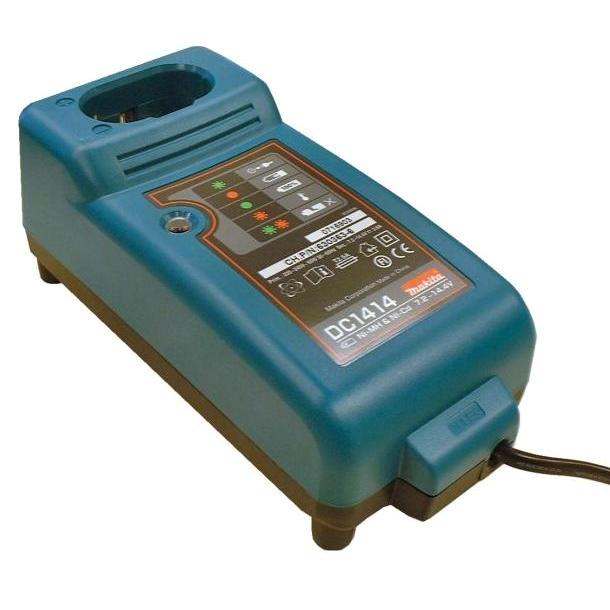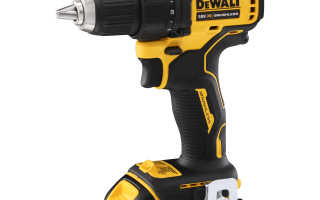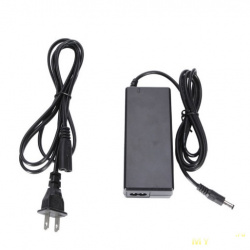Can a lithium-ion battery be charged without a controller?
Yes, you can. However, this will require tight control over the charging current and voltage.
In general, charging the battery, for example, our 18650 without a charger, will not work. All the same, you need to somehow limit the maximum charge current, so at least the most primitive charger is still required.
The simplest charger for any lithium battery is a resistor in series with the battery:
The resistance and power dissipation of the resistor depends on the voltage of the power supply that will be used for charging.
Let's calculate the resistor for a 5 volt power supply as an example. We will charge a 18650 battery with a capacity of 2400 mAh.
So, at the very beginning of charging, the voltage drop across the resistor will be:
Ur = 5 - 2.8 = 2.2 Volts
Suppose our 5-volt power supply is rated for a maximum current of 1A. The circuit will consume the largest current at the very beginning of the charge, when the voltage on the battery is minimal and is 2.7-2.8 Volts.
Attention: these calculations do not take into account the possibility that the battery can be very deeply discharged and the voltage on it can be much lower, down to zero.
Thus, the resistance of the resistor required to limit the current at the very beginning of the charge at the level of 1 Ampere should be:
R = U / I = 2.2 / 1 = 2.2 Ohm
Resistor Dissipation Power:
Pr = I2R = 1 * 1 * 2.2 = 2.2 W
At the very end of the battery charge, when the voltage on it approaches 4.2 V, the charge current will be:
Icharge = (Usp - 4.2) / R = (5 - 4.2) / 2.2 = 0.3 A
That is, as we can see, all values do not go beyond the permissible for a given battery: the initial current does not exceed the maximum allowable charge current for a given battery (2.4 A), and the final current exceeds the current at which the battery stops gaining capacity ( 0.24 A).
The main disadvantage of such charging is the need to constantly monitor the voltage on the battery. And manually disconnect the charge as soon as the voltage reaches 4.2 Volts. The fact is that lithium batteries do not tolerate even short-term overvoltage very badly - the electrode masses begin to degrade quickly, which inevitably leads to a loss of capacity. At the same time, all the prerequisites for overheating and depressurization are created.
The protection built into the battery will not allow it to be recharged under any circumstances. All that remains for you to do is to control the charge current so that it does not exceed the permissible values for the given battery (unfortunately, protection boards do not know how to limit the charge current).
Charging with a laboratory power supply
If you have a current-limited power supply at your disposal, you are saved! Such a power source is already a full-fledged charger that implements the correct charge profile, which we wrote about above (CC / CV).
 All you need to do to charge the li-ion is to set 4.2 volts on the power supply and set the desired current limit. And you can connect the battery.
All you need to do to charge the li-ion is to set 4.2 volts on the power supply and set the desired current limit. And you can connect the battery.
Initially, when the battery is still discharged, the laboratory power supply will operate in current protection mode (i.e., it will stabilize the output current at a given level). Then, when the voltage on the bank rises to the set 4.2V, the power supply will enter the voltage stabilization mode, and the current will begin to drop.
When the current drops to 0.05-0.1C, the battery can be considered fully charged.
As you can see, a laboratory PSU is almost an ideal charger! The only thing that he does not know how to do automatically is to make the decision to fully charge the battery and turn off. But this is a trifle that is not even worth paying attention to.
How can you charge a screwdriver battery without a charger?
- Main classification
- Step-by-step instruction
- Conclusion on the topic
Before charging the screwdriver battery without a charger, you will need to study the instructions. A homemade charger is made taking into account the type of battery.

Varieties of screwdrivers.
Main classification
Experts distinguish the following categories of a screwdriver:
- domestic;
- semi-professional;
- professional.
Since the battery is designed for a specific job and load, each type of tool requires a suitable charger. The operating time of the tool depends on the power of the battery. Experts identify the following types of batteries:
Table of characteristics of batteries for a screwdriver.
The 2nd type of battery, unlike the others, is compact and has a higher energy capacity.
If used correctly, the tool can be charged more than 1000 times. It is necessary to charge the battery of the screwdriver subject to the following rules:
- Full battery charge. Otherwise, the capacity of the energy carrier and the duration of the tool's operation will decrease.
- Nickel-cadmium battery toxicity (do not drop).
- The nickel-metal hydride battery is developed using a new technology and is environmentally friendly for humans. It can be charged frequently. If the tool is not in use, then the battery is stored in a charged state. When the screwdriver is at rest for a long time, the battery is completely discharged.
- The lithium-ion device has no memory effect. The battery has a high power consumption. Due to its exposure to the negative effects of low temperatures, the lithium-ion battery is not used in winter.
To charge the battery for a screwdriver with your own hands, you will need the following materials and tools:
Decoding of indicators of the charger.
- charging glass;
- damaged battery;
- 2 wires 15 cm long;
- soldering iron;
- screwdriver;
- drill;
- knife;
- thermal gun.
Using a soldering iron, the terminals of the damaged battery are soldered. Markers on the lid of the device make notes where the minus and plus were. If necessary, the prepared holes are adjusted to the required dimensions. For this, a blade is used.
The next step is to run the wire through the holes. The cable is soldered to the glass taking into account the polarity. To prevent the connector from falling apart, cardboard is inserted into the battery. The bottom cover is attached to the charging glass. The resulting structure is inserted into the adapter and then into the battery.
To charge the device, you can make a charger from a USB source. To do this, use an outlet, USB charger, fuse (10 A), connectors, paint, electrical tape and tape. The screwdriver is disassembled into parts. The upper body is cut off from the handle with a knife.
Charger circuit for a screwdriver.
A hole for the fuse is made on the side of the handle. The wire is connected to a fuse and mounted in the handle of the unit.
How to bypass protection
The socket to which the screwdriver battery is connected contains four terminals. Two of them are negative and positive. The other two terminals go to the protection relay against short circuit, overheating and other things. To bypass the protection and not deal with the electrical circuit, you can use an unnecessary battery from the drill.

Screwdriver battery disassembled
The screwdriver battery is removed from the case. A small white plastic box will say that it is a heat shield. This element, together with the black wires, must be evaporated and soldered to the terminals of the charger. Now the white and black wires are soldered to the protection, observing the polarity.
When connecting a battery or other devices, the indicator should show that charging is working properly. If you just turn on the charger, it will blink, indicating that you need to put the battery. That is, the blinking will disappear and the red light will be on. When the battery or other device is fully charged, the green light should light up.

An example of a connection diagram for charging a screwdriver to a car battery
To charge the car battery, a wire is led out from the side of the case. You need to connect the terminal blocks, and then connect the wire to the mains. Otherwise, the protection system will work and charging will not start. The positive and negative wires are connected to the corresponding terminals of the car battery. With proper operation, the charger should not overheat or melt.

Connecting the terminals to the screwdriver charging
Safety and Precautions
Basic safety requirements when charging power sources for the instrument from non-standard charging blocks:
- The tool uses direct current to charge the batteries.
- The connection is made with cables with a protective insulator; it is necessary to provide for a reliable fixation of the electrical wiring on the contact plugs of the batteries.
- When the capacity of the elements is replenished, heating occurs, accompanied by the release of gases. The battery cells are equipped with emergency valves, but the leaked component is not suitable for further operation.
- It is recommended to carry out work in a ventilated area, eyes and hands are protected with personal protective equipment. If the case overheats, smoke or electrolyte traces appear on the can case, charging stops immediately. Reconnection is performed after finding out the causes of the malfunction.
- Connecting power adapters that are not designed to charge the screwdriver battery is a last resort. Due to the inconsistency of the current parameters, the circuit components operate with overload, which causes increased heating and fire. Continuous use of non-original charging blocks is not recommended.
How to properly charge lithium batteries
There are several schemes for charging lithium batteries. The two-stage charging developed by SONY is more commonly used. Devices using pulse charging and step charging, as for acid batteries, are not used.
Charging any type of lithium ion or lithium polymer battery requires strict voltage compliance. One cell of a charged lithium battery should be no more than 4.2 V. The nominal voltage for them is 3.7 V.
Lithium batteries can be charged quickly, not fully? Yes. You can always recharge them. Battery operation by 40-80% capacity lengthens the battery shelf life.

Lithium battery two-stage charging circuit
CC / CV circuit principle - constant charging current / constant voltage. How to charge a lithium battery using this scheme?
The diagram before stage 1 of charging shows a pre-stage for restoring a deeply seated lithium battery, with a voltage at the terminals of at least 2.0 V. The first stage should restore 70-80% of the capacity. The charging current is chosen 0.2-0.5 C. It is possible to accelerate charging with a current of 0.5-1.0 C. (C is the capacity of lithium batteries, digital value). What should be the charging voltage in the first stage? Stable, 5 V. When the voltage at the battery terminals 4.2 is reached, this is a signal to go to the second stage.
Now the charger maintains a stable voltage at the terminals, and the charging current decreases as the capacity rises. When its value decreases to 0.05-0.01 C, charging will end, the device will turn off, preventing overcharging. The total recovery time for a lithium battery does not exceed 3 hours.
If the lithium-ion battery is discharged deeper than 3.0 V, a "jolt" will be required. This consists in charging with a small current until the terminals are at 3.1 V. Then the usual circuit is used.

How charging parameters are monitored
Since lithium batteries operate in a narrow range of voltage changes at the terminals, they cannot be recharged above 4.2 V and discharged below 3 V. The charge controller is installed in the charger.But each battery or battery has its own breakers, PCB board or PCM protection modules. In the batteries, it is precisely the protection against one factor or another that is installed. In case of violation of the parameter, it must turn off the bank, break the circuit.
A controller is a device that must implement control functions - switch CC / CV modes, control the amount of energy in banks, turn off charging. In this case, the assembly works, heats up.

Homemade charging circuits used for lithium batteries
- LM317 is a simple charger circuit with a charge indicator. Does not supply power from the USB port.
- MAX1555, MAX1551- special for Li Batteries, install in phone to USB power adapter. There is a pre-charge function.
- LP2951- stabilizer limits the current, forms a stable voltage of 4.08-4.26V.
- MCP73831 is one of the simplest circuits, suitable for charging ionic and polymer devices.
If the battery consists of several cells, they are not always discharged evenly. When charging, you need a balancer that distributes the charge and ensures that all the cells in the battery are charged evenly. The balancer can be separate or built into the battery connection diagram. The battery protection device is called BMS. Knowing how to charge devices, understanding the circuits, you can do it yourself with a circuit of a protective device for a lithium battery.
How to charge a screwdriver battery without a charger?
The situation when the screwdriver charger is unavailable or out of order cannot be called standard, so there is no easy solution to this problem. The best way out of this situation is to find and purchase a charger suitable for your model, since only it can safely and efficiently charge the batteries of your instrument. If this is not possible, there are fallbacks:
- charge the battery with a car charger;
- purchase a universal charger;
- convert a power tool to be powered by an external battery.
Using a car charger
The main danger when using this method is overcharging the battery. The batteries used in power tools differ in their characteristics from automotive lead-acid batteries. A charger equipped with electronic current and voltage control is suitable.
The charging current is selected at the rate of 0.5 to 0.1 of the battery capacity in Ah. So, with a capacity of 1.3 Ah, the charging current is set from 650 to 130 mA. Lead acid chargers are designed to handle high currents, and the required value may be out of range. In this case, a ballast resistor connected in series with the battery is used to limit the current. A car lamp can be used as a resistance.
Universal chargers
The purchase of such a device is justified if, in addition to the screwdriver at home, there are other battery-powered equipment. This capacity can be laboratory power supplies or model chargers. The advantage of this type of devices is their versatility and many adjustments, with which you can set the required charging mode.
Using an external power source
This is not the most convenient option in terms of operation. In the case when the tool is already old, and purchasing additional equipment for it is too large an expense, it can be used. A battery with the correct voltage is suitable for this upgrade. When using a powerful battery, motor protection should be provided. The easiest option is a 10 A fuse in the power circuit. Do not forget that the wires, when using low voltage, must have a larger cross section than when powered from a 220 V.
When using non-standard equipment for charging the screwdriver, make sure that the devices are connected correctly, that the charging mode corresponds to the technical characteristics of the battery, and ensure the safety of the process.
How to charge a screwdriver battery without a charger: safety
Before using any other charging method, except for the native charger, it should be remembered that:
- The process must be continuously monitored; at the end of filling the battery, it is recommended to stop the procedure, because from overflow, the electrolytic cells of the battery are capable of boiling, the temperature will rise sharply, the appearance of the slightest spark will explode the entire structure;
- Non-native, homemade chargers threaten to completely ruin the battery, excluding the possibility of its subsequent restoration;
- It is necessary to ensure the correct inclusion of all elements of the circuit, strict consideration of the technical parameters of the battery when installing the circuit, the safety of the procedure, the observance of polarity;
- If the characteristics of the modules differ slightly (for example, 10 and 13 volts), then the battery cannot be charged for a long time.
Additional useful information
Rechargeable batteries are available in different versions: lithium, nickel-metal hydride, -cadmium. The most simple charging of powerful lithium blocks, the replenishment of the charge of the other two types has some peculiarities. The charging time of different batteries is also not the same - from 0.5 h to 7 h. The cadmium modules are filled for the longest time (7 hours).
The considered methods of solving such a problem as charging the battery of a screwdriver without a charger are not acceptable for every type of power tool. Before you start experimenting, you need to take into account all the technical features of the devices used, materials, so as not to damage the power tool itself, your health, property or real estate.
A screwdriver equipped with a battery makes it possible to fully work where it is not possible to connect to an electrical outlet. This simplifies construction and repair.
The screwdriver itself is in excellent condition, but the charger is lost, it turns out to be unrealistic to find the same.
How to charge a screwdriver battery without a charger?
If you understand the basics of electromechanics, you will find the voltage and capacity of the battery on a battery or a screwdriver, on the case of a battery or a screwdriver, you will find the polarity - this is the main thing!
It is necessary to determine its charging characteristics from the data, for example, an 18V battery and a capacity of 2 A / h - which means you need a charger capable of giving a charging current of 18V and a capacity of about 200 mA / hour, since it charges for a longer time, but with a lower power charge it is enough take 8-10 times less, adjust on a charger, or purchase with just such characteristics.
To supply charging current to the battery, use small crocodiles by simply hanging them on the current distribution plates of the battery connector.
Conventional rectifier for car batteries
It is extremely important not to mix up the polarity of the connection, because not all batteries for screwdrivers have a + designation - like Makita, for example. It is better to have a tester at hand
A current of 1 ampere is enough and the charging duration should not be more than half an hour, under constant supervision.
Although this method can save the situation once or twice, it would not be necessary to use it all the time. To comply with the battery life declared by the manufacturer, you need to use only original chargers that provide the required voltage and charging current.
Can be charged with a car charger (charger).
We set the minimum voltage on the device itself.
We remove the battery of the screwdriver, determine exactly where we have a plus and where we have a minus (although the batteries are different, there may be nuances).
The terminals from the charger can be connected directly to the battery of the screwdriver, sometimes it is not possible, you need to slightly improve this unit, using, for example, paper clips or plates.
In general, that's all, we turn on the charger so as not to risk the battery of the screwdriver, control the charging duration, 15 minutes, 20 minutes will be enough for a start, as soon as the battery of the screwdriver becomes warm, disconnect the charger.
Here is a video on the topic,
a man used an Orion PW-260 charger to charge the battery of a Hyundai screwdriver.
Better yet, of course, buy a native (or at least a similar) charger, in the markets you can find almost any, even for an old model of a screwdriver.
How long does it take to charge the battery of the screwdriver
Each power tool is always accompanied by an instruction manual, which indicates exactly how long it takes to charge the screwdriver's battery. As already mentioned, the vast majority of modern chargers have charge level indicators, which makes them much easier to use. When the indicator lights up green, or in another color, indicating that the charging time of the screwdriver battery is coming to an end, you need to disconnect the battery in time.
The average time it takes for the battery to fully charge is 7 hours. And if the battery just needs to be recharged, it can be left on charge for 30 minutes. Although, in the case of Ni Cd batteries with a "memory effect", frequent and short recharges are not recommended.
There are several types of screwdriver chargers, depending on their area of application. Ordinary charger, as a rule, is included in the package of household power tools. The battery charging time with it varies from three to seven hours. There are also powerful pulse-type chargers that come with professional tools. How much to charge the battery of a screwdriver with such a device? "Impulses" can fully charge the battery within an hour, which is their indisputable advantage. However, the cost of such a tool, of course, is much higher.
How long to charge, and what does this time depend on
It will take at least 2-3 hours, in this case the charge will be enough to start the car engine. You can fully charge the battery, but it will take 8-14 hours. When the device is completely discharged, it takes a minimum of 15 hours to fully charge until it is fully recovered. If a low voltage charger is used, it will take longer to charge. To get a more accurate figure, you need to take into account the battery capacity.

In about 2 hours, the battery should reach its starting capacity. You can check if the charge level has changed by measuring the voltage. The numbers on the multimeter screen must be compared with the readings in the discharged state. If it was about 16 V, but it became 1-2 Volts more, then everything is working fine.
After carrying out the manipulations, the charge level is checked again. To do this, connect a load plug or simply connect the battery to the on-board network. If the starter is spinning, then the operation was successful.



